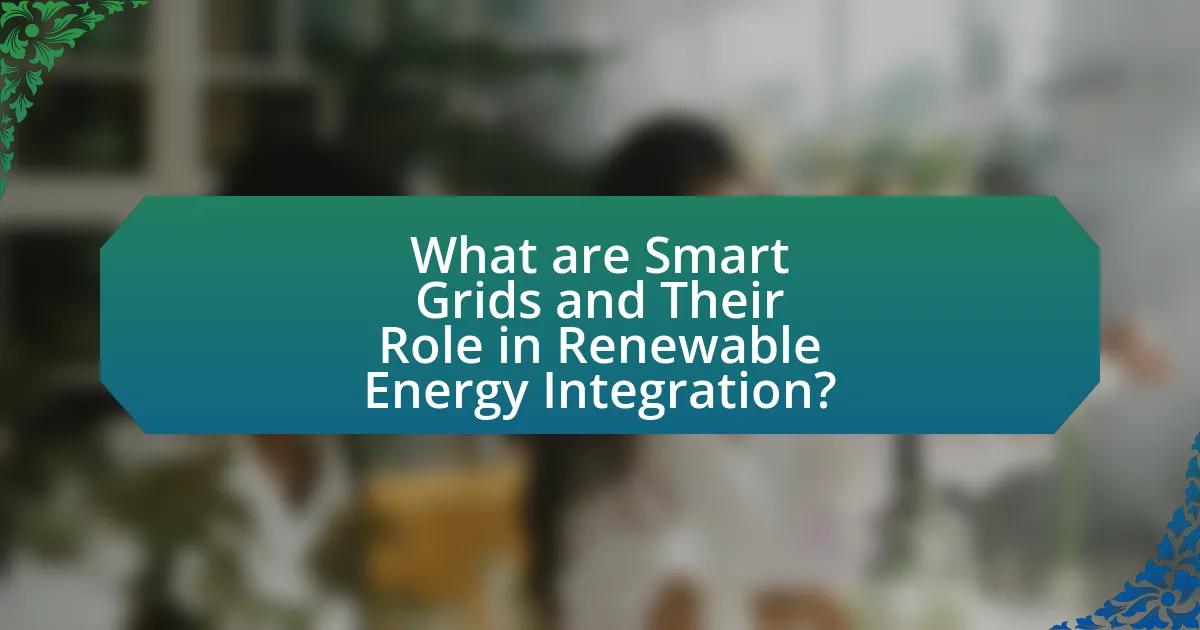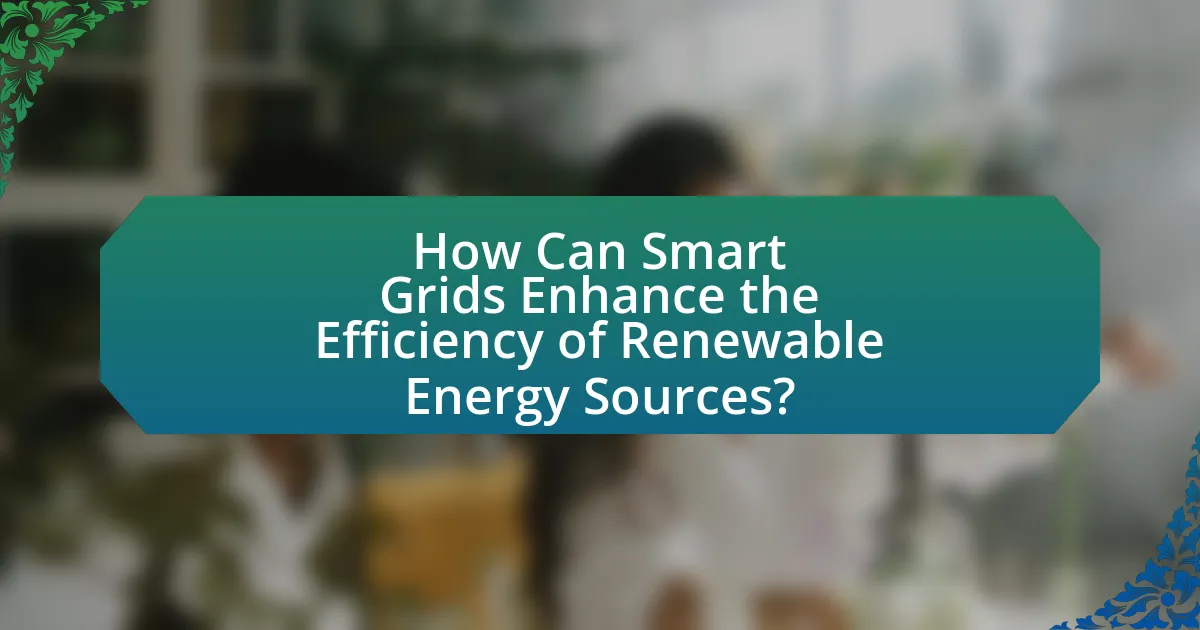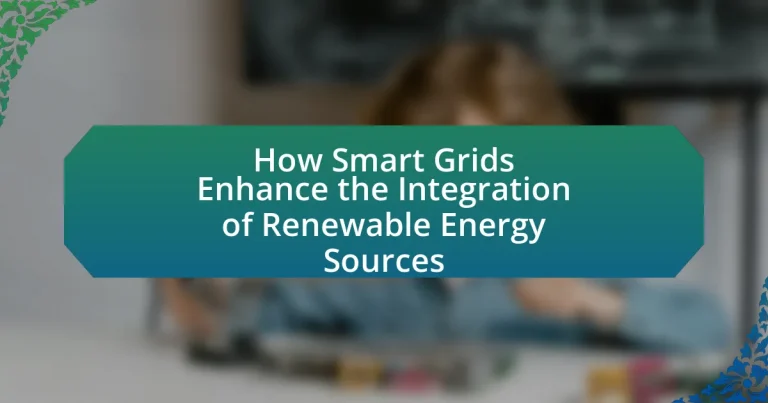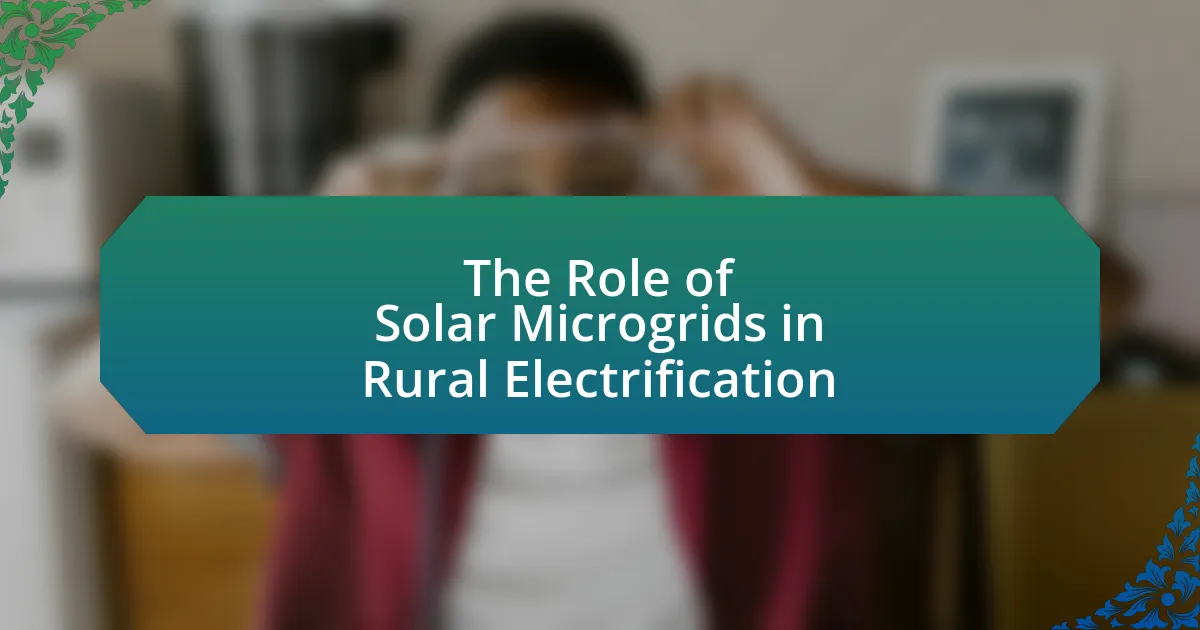Smart grids are advanced electrical systems that leverage digital technology to enhance the management and distribution of electricity, playing a vital role in the integration of renewable energy sources such as solar and wind. This article explores how smart grids function, the essential technologies involved, and their impact on energy efficiency and reliability. It also addresses the environmental benefits of renewable energy integration, the challenges faced by smart grids, and the importance of regulatory frameworks and consumer participation in optimizing energy use. By examining these aspects, the article highlights the significant contributions of smart grids to achieving a sustainable energy future.

What are Smart Grids and Their Role in Renewable Energy Integration?
Smart grids are advanced electrical grids that utilize digital technology to monitor and manage the transport of electricity from all generation sources to meet the varying electricity demands of end users. Their role in renewable energy integration is crucial, as they facilitate the incorporation of diverse energy sources, such as solar and wind, into the existing power infrastructure. Smart grids enhance the efficiency and reliability of energy distribution by enabling real-time data communication, which allows for better demand response and grid management. This capability is supported by the U.S. Department of Energy, which states that smart grid technologies can significantly increase the share of renewable energy in the energy mix, thereby reducing greenhouse gas emissions and improving energy security.
How do Smart Grids function in the context of energy distribution?
Smart grids function by utilizing advanced communication and automation technologies to optimize energy distribution. They enable real-time monitoring and management of electricity flow, allowing for efficient integration of renewable energy sources like solar and wind. By employing sensors, smart meters, and data analytics, smart grids can dynamically balance supply and demand, reduce energy losses, and enhance grid reliability. For instance, according to the U.S. Department of Energy, smart grid technologies can reduce peak demand by up to 15%, demonstrating their effectiveness in improving energy distribution efficiency.
What technologies are essential for Smart Grids?
Essential technologies for Smart Grids include advanced metering infrastructure (AMI), demand response systems, energy management systems (EMS), and distributed energy resources (DER) integration technologies. AMI enables real-time data collection and communication between utilities and consumers, facilitating efficient energy usage and billing. Demand response systems allow for the adjustment of consumer energy usage based on supply conditions, enhancing grid reliability. EMS optimizes energy production and consumption, while DER integration technologies support the incorporation of renewable energy sources, such as solar and wind, into the grid. These technologies collectively enhance the efficiency, reliability, and sustainability of energy systems, crucial for integrating renewable energy sources effectively.
How do Smart Grids manage energy flow from renewable sources?
Smart Grids manage energy flow from renewable sources by utilizing advanced communication and control technologies to optimize the distribution and consumption of electricity. These systems integrate real-time data from various renewable energy sources, such as solar panels and wind turbines, allowing for efficient energy management. For instance, Smart Grids employ demand response strategies that adjust energy consumption based on supply availability, ensuring that excess energy generated during peak production times is effectively utilized or stored. Additionally, they incorporate energy storage solutions, such as batteries, to balance supply and demand fluctuations. This capability is supported by the increasing deployment of smart meters and sensors, which provide detailed insights into energy usage patterns, facilitating better decision-making and grid stability.
Why is the integration of renewable energy sources important?
The integration of renewable energy sources is important because it reduces greenhouse gas emissions and enhances energy security. By incorporating renewable energy, such as solar and wind, into the energy mix, countries can decrease their reliance on fossil fuels, which are major contributors to climate change. For instance, according to the International Renewable Energy Agency, renewable energy could help reduce global CO2 emissions by up to 70% by 2050. Additionally, integrating renewables into the grid diversifies energy supply, making it more resilient to disruptions and fluctuations in demand. This shift not only supports environmental sustainability but also promotes economic growth through job creation in the renewable sector.
What are the environmental benefits of renewable energy integration?
Renewable energy integration significantly reduces greenhouse gas emissions, which are a primary driver of climate change. By utilizing sources such as solar, wind, and hydroelectric power, renewable energy systems emit little to no carbon dioxide during operation. For instance, the U.S. Energy Information Administration reported that in 2020, renewable energy sources accounted for about 20% of electricity generation, leading to a reduction of approximately 1.7 billion metric tons of carbon dioxide emissions compared to fossil fuels. Additionally, renewable energy integration helps decrease air pollutants, improving air quality and public health. The World Health Organization estimates that air pollution causes around 7 million premature deaths annually, and transitioning to cleaner energy sources can mitigate these health risks. Furthermore, renewable energy systems promote biodiversity by reducing habitat destruction associated with fossil fuel extraction and use. Overall, the environmental benefits of renewable energy integration are substantial, contributing to a more sustainable and healthier planet.
How does renewable energy integration impact energy security?
Renewable energy integration enhances energy security by diversifying energy sources and reducing dependence on fossil fuels. This diversification mitigates risks associated with supply disruptions, as renewable sources like solar and wind are abundant and locally available. For instance, a study by the International Renewable Energy Agency (IRENA) indicates that countries with higher shares of renewable energy experience greater energy independence and resilience against geopolitical tensions. Furthermore, integrating renewable energy into smart grids allows for real-time monitoring and management of energy flows, improving reliability and stability in energy supply. This capability is crucial during peak demand periods or emergencies, reinforcing the overall security of the energy system.

What Challenges Do Smart Grids Face in Integrating Renewable Energy?
Smart grids face several challenges in integrating renewable energy, primarily due to the variability and unpredictability of renewable sources like solar and wind. This variability can lead to difficulties in maintaining grid stability and reliability, as traditional grid systems are designed for consistent energy supply. Additionally, the existing infrastructure may require significant upgrades to accommodate distributed energy resources, which can involve high costs and complex regulatory hurdles. Furthermore, the need for advanced energy management systems and real-time data analytics to optimize energy flow adds another layer of complexity. These challenges are underscored by studies indicating that without proper integration strategies, the potential benefits of renewable energy sources may not be fully realized, impacting overall energy efficiency and sustainability goals.
What technical barriers exist for Smart Grids?
Technical barriers for Smart Grids include interoperability issues, cybersecurity vulnerabilities, and the need for advanced communication infrastructure. Interoperability challenges arise from the diverse technologies and standards used by different manufacturers, which can hinder seamless integration and data exchange. Cybersecurity vulnerabilities pose significant risks, as Smart Grids are susceptible to cyberattacks that can disrupt operations and compromise sensitive data. Additionally, the requirement for advanced communication infrastructure is critical, as existing systems may not support the high-speed data transfer necessary for real-time monitoring and control of energy resources. These barriers must be addressed to fully realize the potential of Smart Grids in enhancing the integration of renewable energy sources.
How do grid stability and reliability issues affect integration?
Grid stability and reliability issues significantly hinder the integration of renewable energy sources into the power system. When grid stability is compromised, it can lead to fluctuations in voltage and frequency, making it challenging to maintain a consistent power supply. For instance, the intermittent nature of renewable energy, such as solar and wind, exacerbates these stability issues, as their output can vary rapidly based on environmental conditions. According to the U.S. Department of Energy, integrating a higher percentage of renewables requires advanced grid management techniques to ensure reliability, including energy storage solutions and demand response strategies. These measures are essential to mitigate the risks associated with grid instability, thereby facilitating a smoother integration of renewable energy sources into the existing infrastructure.
What role does energy storage play in overcoming these challenges?
Energy storage plays a crucial role in overcoming the challenges associated with integrating renewable energy sources into smart grids. By storing excess energy generated during peak production times, such as sunny or windy periods, energy storage systems ensure a reliable supply during periods of low generation, thus stabilizing the grid. For instance, according to the U.S. Department of Energy, energy storage can reduce the need for fossil fuel backup generation by up to 30%, enhancing grid resilience and efficiency. This capability not only helps balance supply and demand but also facilitates the increased adoption of renewable energy, ultimately leading to a more sustainable energy system.
What regulatory and policy challenges impact Smart Grid implementation?
Regulatory and policy challenges significantly impact Smart Grid implementation by creating barriers to investment, innovation, and integration of renewable energy sources. These challenges include outdated regulatory frameworks that do not accommodate new technologies, inconsistent policies across jurisdictions that complicate compliance, and a lack of incentives for utilities to invest in Smart Grid infrastructure. For instance, the Federal Energy Regulatory Commission (FERC) has noted that regulatory uncertainty can hinder the deployment of advanced metering and demand response programs, which are essential for Smart Grid functionality. Additionally, the absence of standardized interconnection procedures can delay the integration of distributed energy resources, further complicating the transition to a Smart Grid.
How do government incentives influence renewable energy integration?
Government incentives significantly enhance renewable energy integration by providing financial support and regulatory frameworks that lower barriers to entry for renewable technologies. These incentives, such as tax credits, grants, and feed-in tariffs, encourage investment in renewable energy projects, making them more economically viable. For instance, the U.S. federal Investment Tax Credit (ITC) allows for a 26% tax credit for solar energy systems, which has led to a substantial increase in solar installations, contributing to a 167% growth in solar capacity from 2016 to 2020. Additionally, government policies that mandate renewable energy usage, like Renewable Portfolio Standards (RPS), create a market for renewable energy, further driving integration into the energy grid.
What are the implications of energy market structures on Smart Grids?
Energy market structures significantly influence the functionality and efficiency of Smart Grids. These structures determine how electricity is bought, sold, and distributed, impacting the integration of renewable energy sources. For instance, decentralized market models promote local energy trading, enabling Smart Grids to optimize the use of distributed energy resources like solar and wind. Research indicates that regions with competitive energy markets see a 20% increase in renewable energy adoption due to enhanced flexibility and responsiveness in grid management. Additionally, regulatory frameworks within these market structures can either facilitate or hinder investments in Smart Grid technologies, directly affecting their capacity to manage variable renewable energy outputs effectively.

How Can Smart Grids Enhance the Efficiency of Renewable Energy Sources?
Smart grids enhance the efficiency of renewable energy sources by enabling real-time monitoring and management of energy flows. This technology allows for better integration of variable renewable energy sources, such as solar and wind, by optimizing energy distribution based on demand and supply conditions. For instance, smart grids utilize advanced metering infrastructure and automated demand response systems to balance energy loads, reducing waste and improving reliability. According to the U.S. Department of Energy, smart grid technologies can increase the efficiency of renewable energy integration by up to 30%, demonstrating their significant impact on energy management and sustainability.
What are the benefits of real-time data in Smart Grids?
Real-time data in Smart Grids enhances operational efficiency, improves reliability, and facilitates better integration of renewable energy sources. By providing instantaneous information on energy consumption and generation, Smart Grids enable utilities to optimize energy distribution, reduce outages, and manage demand response effectively. For instance, according to the U.S. Department of Energy, real-time monitoring can lead to a 10-30% reduction in energy losses, demonstrating the tangible benefits of real-time data in enhancing grid performance and supporting the transition to renewable energy.
How does data analytics improve energy management?
Data analytics improves energy management by enabling real-time monitoring and optimization of energy consumption and production. Through the analysis of large datasets from smart meters and sensors, energy providers can identify patterns in usage, forecast demand, and optimize grid operations. For instance, a study by the U.S. Department of Energy found that implementing data analytics in smart grids can lead to a 10-15% reduction in energy consumption by optimizing load distribution and reducing peak demand. This data-driven approach enhances efficiency, reduces costs, and supports the integration of renewable energy sources into the grid.
What role does demand response play in optimizing energy use?
Demand response plays a critical role in optimizing energy use by adjusting consumer demand for electricity in response to supply conditions. This mechanism allows utilities to manage energy consumption during peak periods, thereby reducing the need for additional power generation and enhancing grid reliability. For instance, studies have shown that demand response programs can lead to a reduction in peak demand by up to 15%, which directly contributes to lower energy costs and improved efficiency in the use of renewable energy sources. By incentivizing consumers to shift their energy usage to off-peak times, demand response facilitates a more balanced load on the grid, ultimately supporting the integration of renewable energy and minimizing reliance on fossil fuels.
How do Smart Grids facilitate consumer participation in energy markets?
Smart grids facilitate consumer participation in energy markets by enabling real-time communication and data exchange between utilities and consumers. This technology allows consumers to monitor their energy usage, participate in demand response programs, and engage in peer-to-peer energy trading. For instance, smart meters provide detailed consumption data, empowering consumers to make informed decisions about their energy use and costs. Additionally, studies show that regions with smart grid implementations have seen increased consumer engagement, with a 20% rise in participation in demand response programs, leading to more efficient energy consumption and integration of renewable sources.
What are the advantages of decentralized energy generation for consumers?
Decentralized energy generation offers consumers increased energy independence and potential cost savings. By producing energy locally, consumers can reduce reliance on centralized power plants and mitigate transmission losses, which can account for up to 10% of energy loss in the grid. Additionally, decentralized systems, such as solar panels, can lower electricity bills through net metering, where excess energy is sold back to the grid. This model has been shown to enhance energy resilience, as local generation can provide power during outages, improving overall reliability. Furthermore, decentralized energy generation supports the integration of renewable sources, contributing to a reduction in greenhouse gas emissions and promoting sustainable energy practices.
How can consumers benefit from smart metering technologies?
Consumers can benefit from smart metering technologies by gaining real-time access to their energy consumption data, which enables them to make informed decisions about their energy use. This immediate feedback allows consumers to identify peak usage times, adjust their habits to save on energy costs, and participate in demand response programs that can further reduce their bills. According to a study by the U.S. Department of Energy, homes equipped with smart meters can reduce energy consumption by up to 15% due to increased awareness and behavioral changes. Additionally, smart metering facilitates the integration of renewable energy sources, allowing consumers to take advantage of lower rates during off-peak times when renewable energy is abundant.
What best practices can be adopted for effective Smart Grid implementation?
Effective Smart Grid implementation can be achieved by adopting best practices such as stakeholder engagement, robust cybersecurity measures, and the integration of advanced metering infrastructure. Stakeholder engagement ensures that all parties, including utilities, consumers, and regulators, collaborate effectively, which is crucial for addressing diverse needs and expectations. Robust cybersecurity measures protect the grid from potential threats, as evidenced by the increasing number of cyberattacks on energy infrastructure, highlighting the need for secure systems. The integration of advanced metering infrastructure facilitates real-time data collection and analysis, enabling better demand response and energy management, which is essential for optimizing the use of renewable energy sources. These practices collectively enhance the reliability and efficiency of Smart Grids, ultimately supporting the transition to a more sustainable energy system.




